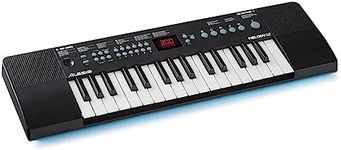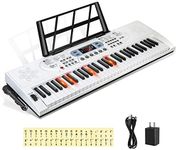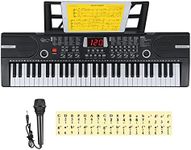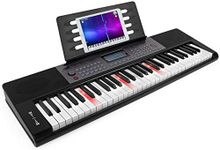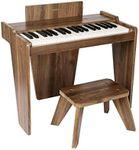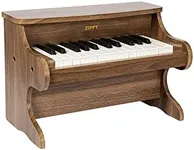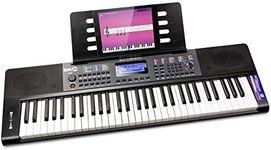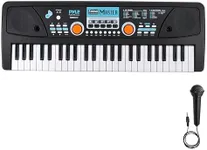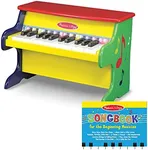Buying Guide for the Best Kids Piano Keyboard
Choosing a kids' piano keyboard can be a fun and rewarding experience, especially if you want to encourage a child's interest in music. The right keyboard can help develop musical skills, creativity, and even confidence. When shopping for a kids' piano keyboard, it's important to consider features that match the child's age, skill level, and interests. Understanding the key specifications will help you make a choice that keeps your child engaged and supports their learning journey.Number of KeysThe number of keys on a kids' piano keyboard determines how many notes the child can play. Full-sized pianos have 88 keys, but kids' keyboards often come with fewer, such as 25, 37, 49, or 61 keys. Fewer keys make the keyboard lighter and easier for small hands to manage, which is great for beginners or younger children. If the child is just starting out or is very young, a keyboard with 25 to 37 keys is usually enough. For older kids or those who show more interest, a 49 or 61-key keyboard offers more range and room to grow.
Key Size and TouchKey size refers to whether the keys are full-sized like a real piano or mini-sized for smaller hands. Mini keys are easier for young children to play, while full-sized keys are better for those who may transition to a real piano later. Touch sensitivity means the keys respond to how hard they are pressed, which helps with musical expression. For most young beginners, mini keys and non-touch-sensitive keyboards are fine, but if the child is older or more serious, full-sized and touch-sensitive keys can be more beneficial.
Built-in Sounds and RhythmsMany kids' keyboards come with a variety of built-in sounds (like different instruments) and rhythms (background beats). These features make playing more fun and can keep children interested for longer. If the child enjoys experimenting and being creative, look for a keyboard with a good selection of sounds and rhythms. For those who want a more traditional piano experience, fewer extra sounds may be better to avoid distractions.
Portability and Power OptionsPortability refers to how easy it is to move the keyboard around. Lightweight keyboards are easier for kids to carry and can be used in different rooms or even taken to friends' houses. Power options include batteries or an AC adapter. Battery-powered keyboards are great for portability, while an AC adapter is useful for longer practice sessions at home. Consider where and how the keyboard will be used most often to decide which features are most important.
Learning FeaturesSome keyboards come with built-in learning tools, such as light-up keys, lesson modes, or apps that help teach songs and basic music skills. These features can make learning more engaging and help children progress at their own pace. If the child is a complete beginner or enjoys interactive learning, these features can be very helpful. For kids who already have some piano experience, these may be less necessary.
Durability and Build QualityKids can be tough on their toys and instruments, so it's important to choose a keyboard that is sturdy and well-built. Look for keyboards made from durable materials and with keys that can withstand frequent use. If the keyboard will be used by very young children or in a busy household, durability should be a top priority to ensure it lasts.
Volume Control and Headphone JackVolume control allows you to adjust how loud the keyboard sounds, which is important for home use. A headphone jack lets the child practice quietly without disturbing others. If the keyboard will be used in shared spaces or at times when quiet is needed, these features are very useful.
